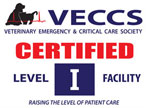Date:
By Alan Green and Samantha Nelson
As pet owners, we often lovingly provide our furry friends a variety of treats and toys. As veterinarians, we often are faced with solving serious and often life threatening scenarios as a result of what our pets consume.
I am pleased to introduce the newest member of the CVRC Surgical Department, Dr. Samantha Nelson, DVM DACVS. Dr. Nelson gives us an important article on what you need to know about dietary indiscretion in our pets.
Our pets love putting things in their mouths, but unfortunately this isn’t limited to food and treats. You may have a dog or cat that loves to chew toys, socks, (insert any random object, edible or not) so much that boom: Down the hatch it goes. Many objects, albeit incomprehensible as “tasty” to us, never cause a problem. However, there are a number of fairly commonly ingested objects that can cause problems, including causing life-threatening obstruction and require emergency abdominal surgery to remove.
How do you know if what your pet just ate will cause a problem? A starting point is based on my experience as a surgeon and what I have commonly taken out of pets’ intestines. Toys are very common. Even toys that are meant for your pet can cause a problem. For example, strong chewers can obliterate even the strongest of toys and swallow pieces that are large enough to get stuck, including Kongs, Nylabones, rope and stuffed toys. In warmer months, two common offenders that are not on owners’ radars are corn cobs and peach pits. Corn cobs are often intentionally fed to dogs as a treat. Unfortunately, cobs do not digest and if swallowed in large pieces they will readily obstruct the intestine. Other favorite but bad treats for dogs include laundry — notably their owners’ socks and underwear, blankets and bedding — and feminine hygiene products. Cats are notorious for swallowing string and yarn. Gorilla Glue is an offender ingested by dogs. Once exposed to the stomach juices, it swells to many times its normal size and quickly causes obstruction.
One type of foreign body that is dreaded by veterinarians is the linear foreign body. A linear foreign body is a special class of foreign body composed of “linear” material (think string, carpet, rope, etc.). This material gets lodged at some higher point in the gastrointestinal tract (e.g. in cats it will often be a string looped around the tongue, or in dogs stuck at the outflow of the stomach), then long pieces will continue to move along the intestinal tract. Because the top portion is stuck but the intestines are trying to move the rest along, the intestines will bunch up, or “accordion” along the material. The string gets pulled tight along the inside of the intestine and quickly starts to act like a knife and cuts into and eventually through the wall of the intestine.
Often their obstruction is not complete early on, so intestine contents can still pass by, but the damage is starting. Therefor the pet may not show signs of the obstruction, or they will be mild or intermittent, resulting in a delay of diagnosis until damage is more severe. Second, once the accordion action starts, damage can be extensive and severe. This can result in having to resect a portion of bowel, septic peritonitis (a fatal condition if untreated due to leakage of intestinal contents into the abdomen) and impaired healing of the intestine after surgery that can lead to septic peritonitis. In general with foreign body obstructions, prognosis with surgery is good (about 90 percent survival), but with linear foreign bodies this decreases to around 80 percent survival due to these increased risks. If septic peritonitis occurs, then survival decreases to as low as 50 percent.
So when should you be concerned about your pet? First, if you have witnessed them ingest any of the above or other objects, you should call your veterinarian. They may recommend inducing vomiting to bring the object up, or recommend immediate evaluation (e.g. some objects should not be vomited up, but may be able to be removed with a scope or may pass on their own). Only your veterinarian can make this assessment. Second, if your pet has vomited more than one or two times, their appetite is decreased or absent, they seem depressed or painful in their abdomen (e.g. hunched posture), then they should be evaluated. While these vague signs could be caused by any number of things, your pet should be evaluated and tests performed to rule out a potentially life-threatening emergency.







